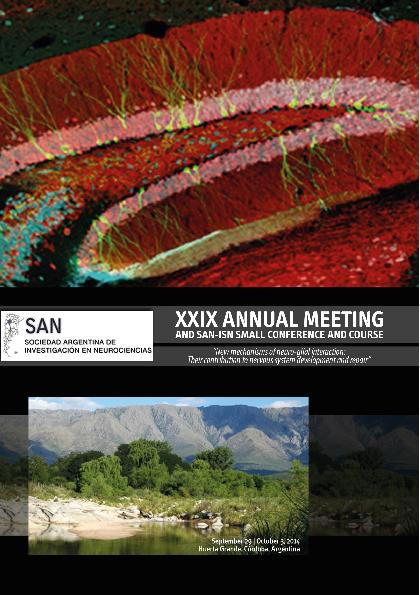Evento
Analysis of expression and function of voltage-activated potassium KCNQ channels on mouse eye
Tipo del evento:
Congreso
Nombre del evento:
XXIX Annual Meeting of Sociedad Argentina de Investigación en Neurociencias
Fecha del evento:
29/10/2014
Institución Organizadora:
Sociedad Argentina e Investigación en Neurociencias;
Título del Libro:
Sociedad Argentina de Investigación en Neurociencias. SAN-ISN Small Conference and course “New mechanisms of neuro-glial interaction: Their contribution to nervous system development and repair”
Título de la revista:
Sociedad Argentina
Editorial:
Sociedad Argentina de Investigación en Neurociencias
Idioma:
Inglés
Clasificación temática:
Resumen
Neuronal potassium channels KCNQ (Kv7) are important for neuron physiology because they regulate their excitability. Four of the five KCNQ channel genes are mutated in human genetic diseases. There are transgenic mice for KCNQ3, -4 and -5 channels, which we used in previous works, allowing the study of protein function and mutation-associated pathologies. Recent publications showed the expression of KCNQ2 to -5 in primate eye and also a possible link between Kcnq5 gen and refractive errors. For these reasons, we investigate the expression and function of these channels in wild-type, Kcnq4-/- and Kcnq5dn/dn mice. We found a weak labeling of KCNQ4 in retinal pigmented epithelium cells, which is enhanced in pigmented cells of ciliary body. KCNQ3 was found only in cells of the non-pigmented epitehlium of the ciliary body. Opposite to what was reported in other species, no KCNQ channel subunits were found in mouse retina. Besides, immature mouse retinal neurons in culture did not show M-like potassium currents, which are generated by KCNQ channels in neurons. Our results suggest that KCNQ channels may participate in the formation of aquous humor of the eye, providing part of the companion positive current during chloride transport trough the epithelium.
Palabras clave:
RETINA
,
KCNQ
,
POTASSIUM
,
CHANNELS
Archivos asociados
Licencia
Identificadores
Colecciones
Eventos(INIBIBB)
Eventos de INST.DE INVEST.BIOQUIMICAS BAHIA BLANCA (I)
Eventos de INST.DE INVEST.BIOQUIMICAS BAHIA BLANCA (I)
Citación
Analysis of expression and function of voltage-activated potassium KCNQ channels on mouse eye; XXIX Annual Meeting of Sociedad Argentina de Investigación en Neurociencias; Huerta Grande; Argentina; 2014; 97-97
Compartir




